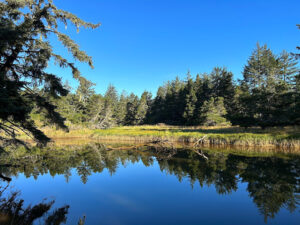
On Sep 11, 2022, we set up camp in site #8 of the Waxmyrtle campground along the Siltcoos River. We liked it so much, this past March we booked the same site for another 5-nighter for early-August and invited a bunch of friends to do the same. It was almost a shame to leave the lovely weather we’d enjoyed so far in Ashland, but booking a getaway to the coast as our fallback has become a given in the event of a smoke event.

There were 5 boats among us, and we explored both directions of the Siltcoos. The estuary of the river is constantly changing, and on one paddle we spotted a small pod of Harbor Seals guarding the mouth of the river. Getting there was approximately ½ mile from camp, and the channel winds between barren dunes protected as breeding habitat for the Snowy Plover.
The river at our campsite is impacted by the tide, and our journeys often required maneuvering our shallow-drafted boats through navigable channels. Pointing our boats inland, we’d pass through a marine forest with the bouncing call of Wrentits a common soundtrack. Here and there, a wall of sand might replace the forest, and occasionally the annoying revving of ATV’s (All-terrain Vehicles) could be heard in the distance. Not far from our campground is the Driftwood CG that serves as the base for sand-dune motorists. There’s quite a difference in how the two communities recreate in the wonderful Siuslaw National Forest, and we respected our individual spaces without acrimony.
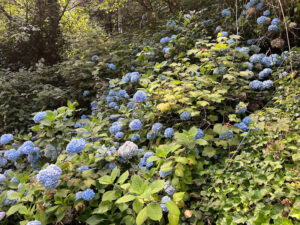
Paddling upstream terminates at a small dam and fish ladder that separates the Siltcoos Lake from its passage to the sea. There’s a portage that permits kayakers to easily pull their boats into the lake, and from there it’s a gentle ½ mile along a narrow inlet into the lake proper. Along the way, we spotted a gorgeous spray of blue Hydrangeas relishing the fresh-water environment as opposed to the brackish marine environment of the river below the dam. As one nears the lake, you pass the Tyee CG. We explored it (along with the massive Honeyman CG) and found both to be far too close to busy Hwy 101. We prefer the tranquility of either Lagoon CG or our personal fav, Waxmyrtle.
Birding (and photographing) from a kayak is different from walking and stalking on foot. Hiking a trail, there are often predictable locations where we’d stop and scan the habitat to see who’s in town. Sometimes a mixed flock of several species would fly together for security and raise a ruckus foraging for food in a shrub or tree. In a boat, you’re impacted by the tide and never really know what will show up. It’s not uncommon for the current to sweep you by an interesting subject before you know it.
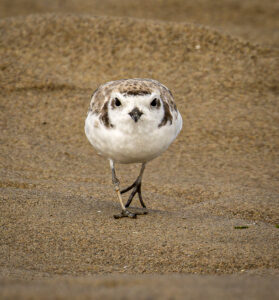
Shorelines are a different thing; there’s a loose relationship between them and boats. Burrowing water creatures are important sources of protein for shorebirds. Beaching the boat provides support and stability for the observer to view species for a long time without frightening them. I like to think birds “see” us as merely logs floating by. If we’re careful not to spook ’em, kayaking at low tide provides a special viewing opportunity. Furthermore, especially when photographing wildlife, getting close to their eye level creates a sense of oneness with your subject. In the case of the adorable Snowy Plover chicks, they appeared oblivious to us as they searched for food in the moist sand. Little fluff balls with oversized legs skittering about on their toes. Sooney pointed out that what appears to be a backwards bent knee is actually their ankle or heel. Their knee does bend forward like a human’s but you usually can’t see it because it’s covered by feathers. Of course, the convenience of a telephoto lens makes all the difference in order to observe these cute critters. But I wouldn’t head out without my binocular.
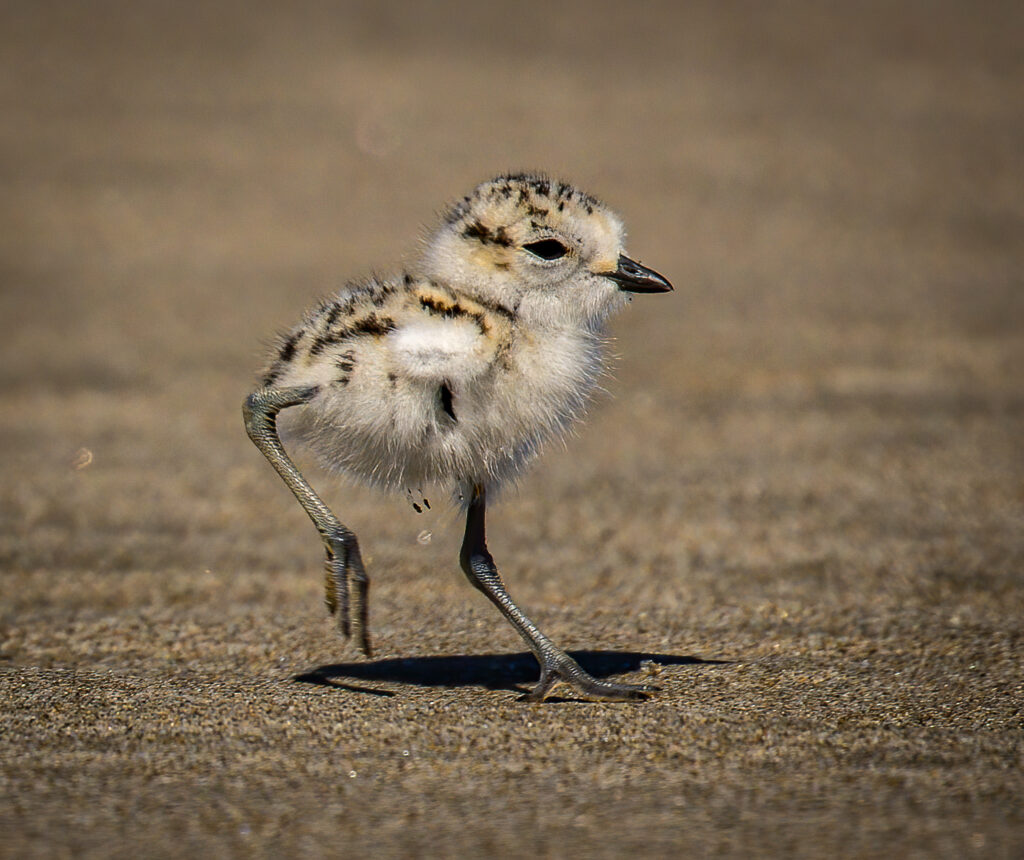
Interestingly, the most significant photo moments were not from a kayak but actually sitting in a comfy camp chair in our campsite. 50′ from our “beach” (where we plopped into our kayaks each morning) is a barren waterlogged tree. At low tide, the twisty trunk, firmly buried into the sandy river bottom, is was popular with shorebirds. A member of a River Otter family climbed onto a lower branch for a brief rest one morning.
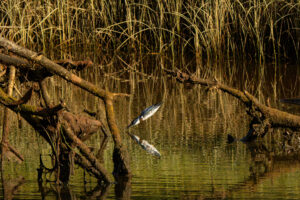
With the return of high tide, the ecosystem changes; much of the snag is submerged and its upper limbs become ideal perches for Belted Kingfishers. We often saw shiny minnows in the shallows as we paddled along, but the sharp-eyed Kingfishers waited patiently for 3-4″ fish from their hunting platforms 6′ above the surface. Unsure if these birds were adults protecting prized fishing locations or juveniles displaying aerobatic flying skills while playing chase overhead, their reverberating mechanical rattle could be heard throughout the day. One thing for sure is that “Belted” only applies to the female. The male Kingfisher (unlike many other male species) does not have the colorful adornment. Once their mind is set on food, however, even the appearance of humans nearby generated little more than a noisy squawk of disapproval. Ideal observing time was early morning–just me and my camera. They’d give me an admonishing look and resume their search for fish with eyesight especially adapted for penetrating water. Several times I observed both male and female birds explode from an upper branch, make 2-3 quick pulls, and then fold back their wings like a rocket. With uncanny accuracy, they’d pierce the surface, grab an unwitting fish in their razor-sharp bills and, after surfacing, use strong chest muscles to slap the water in order to get them airborne. There was a steady flow of different Kingfishers that habituated that snag, and one disappointment was the absence of Cormorants we’d seen this time last year. Same snag, same hunting technique, but I never saw Kingfishers drying out their feathers after a dive. Cormorants would sit for hours, wings outstretched and basking in sunlight; Kingfishers merely return to the hunt relying on oils secreted from gland to maintain buoyancy.
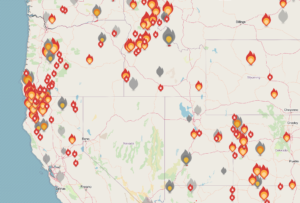
As I write this, the Air Quality in Ashland is a hazardous 493! The smoke that blew into our valley originated from the Head Fire 40 miles SW of us near Yreka, CA, and the first serious smoke deluge this summer. We learned about an app (and website) called Watch Duty that is by far the most comprehensive tool for monitoring fire activity. Highly recommended!
Sadly, we no longer have a getaway to the coast and are hunkering down, masks at the ready. What we DO have are fond memories of great friends gathering together for a week of kayaking, hiking, birding, and just hanging out. Next time we’ll add some music to the fun. Visit sobirds.us to see a gallery from our kayaking camporee.

